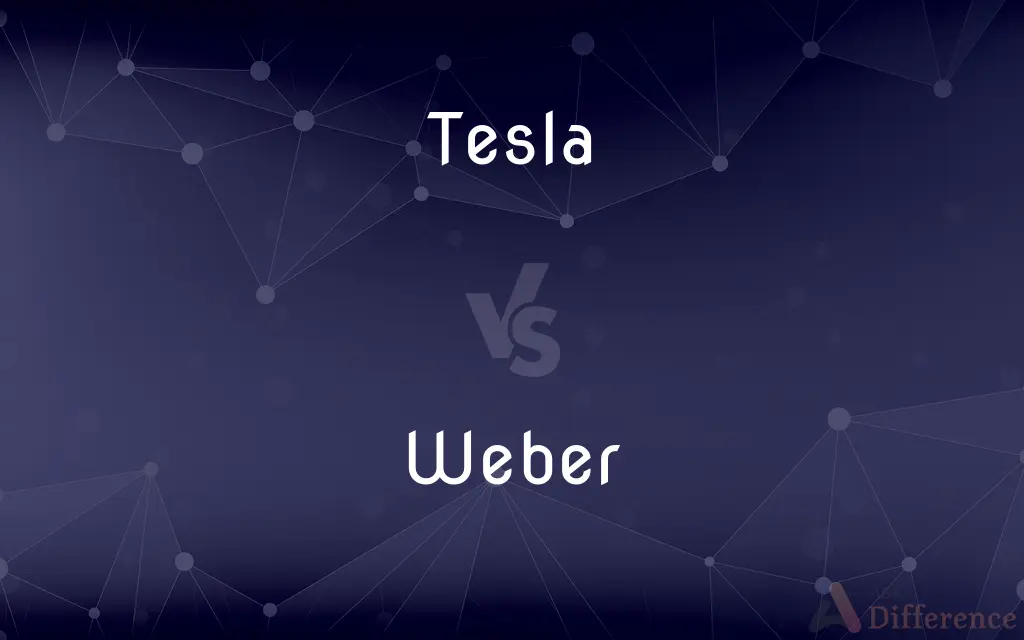Tesla vs. Weber — What's the Difference?
By Maham Liaqat & Urooj Arif — Updated on March 28, 2024
Tesla measures magnetic flux density, while Weber measures magnetic flux.

Difference Between Tesla and Weber
Table of Contents
ADVERTISEMENT
Key Differences
Tesla (T) and Weber (Wb) are units in the International System of Units (SI) used to quantify different aspects of magnetism. Tesla is the SI unit for magnetic flux density (also known as magnetic field strength), which describes the concentration of magnetic field lines in a given area. Weber, on the other hand, is the unit for magnetic flux, representing the total amount of magnetic field passing through an area.
While Tesla quantifies how dense or concentrated a magnetic field is in a particular region, indicating the strength of the magnetic field per unit area, Weber measures the overall magnitude of the magnetic field passing through a given surface, regardless of the area size. This means that the Tesla is used to describe the intensity of a magnetic field at a point, whereas the Weber is used to describe the total magnetic effect over an area.
The relationship between Tesla and Weber can be understood through the formula φ = BAcos(θ), where φ is the magnetic flux in Webers, B is the magnetic flux density in Teslas, A is the area the magnetic field passes through, and θ is the angle between the magnetic field lines and the normal (perpendicular) to the surface. This illustrates how the two units are interrelated but measure different properties of a magnetic field.
In practical applications, Tesla is commonly used in the fields of physics and engineering, especially when dealing with magnetic resonance imaging (MRI) machines, particle accelerators, and magnetic storage media. Weber is also significant in engineering and physics, particularly in the design and analysis of electromagnets, electric motors, and generators.
The choice between Tesla and Weber depends on the aspect of the magnetic field being measured or utilized. For precise magnetic field strength measurements at a point, Tesla is used, while Weber is preferred for calculating the total magnetic effect, such as in electromagnetic induction applications.
ADVERTISEMENT
Comparison Chart
Definition
SI unit of magnetic flux density.
SI unit of magnetic flux.
Measures
Strength of the magnetic field per unit area.
Total magnetic field passing through an area.
Formula Symbol
B
φ
Relation
Describes how concentrated a magnetic field is in a region.
Measures the overall magnitude of the magnetic field.
Application
Used in MRI machines, magnetic storage, and particle accelerators.
Important in the design of electromagnets, electric motors, and generators.
Compare with Definitions
Tesla
Unit for magnetic flux density.
The Earth's magnetic field strength is about 50 microteslas.
Weber
Unit for magnetic flux.
The total magnetic flux through a large electromagnet might be measured in webers.
Tesla
Represents intensity at a point.
High-tesla fields are used in particle accelerators.
Weber
Integral to electromagnetic induction calculations.
Faraday's law of electromagnetic induction uses webers in its formula.
Tesla
Measures how dense a magnetic field is in an area.
Magnetic resonance imaging (MRI) machines operate at several teslas.
Weber
Used to calculate electromagnetic energy transfer.
Transformers are designed considering magnetic flux in webers.
Tesla
Directly related to the force experienced by a moving charge in a magnetic field.
Devices measuring magnetic fields in space often use tesla as a unit.
Weber
Important in understanding and designing magnetic circuits.
The core of an electric motor is designed to optimize flux in webers.
Tesla
Common in applications requiring precise magnetic field strength measurements.
Magnetic storage devices use fields measured in teslas to encode data.
Weber
Measures the total magnetic field through an area.
Electric generators' efficiency can depend on the magnetic flux in webers.
Tesla
The SI-derived unit of magnetic flux density, equal to the magnitude of the magnetic field vector necessary to produce a force of one newton on a charge of one coulomb moving perpendicular to the direction of the magnetic field vector with a velocity of one meter per second. It is equivalent to one weber per square meter. See Table at measurement.
Weber
Weber (, or ; German: [ˈveːbɐ]) is a surname of German origin, derived from the noun meaning "weaver". In some cases, following migration to English-speaking countries, it has been anglicised to the English surname 'Webber' or even 'Weaver'.
Tesla
In the International System of Units, the derived unit of magnetic flux density or magnetic inductivity. Symbol: T
Weber
The SI-derived unit of magnetic flux, equal to the flux that produces an electromotive force of one volt in a conducting loop when the flux is uniformly reduced to zero within one second. See Table at measurement.
Tesla
A unit of magnetic flux density equal to one weber per square meter
Weber
In the International System of Units, the derived unit of magnetic flux; the flux linking a circuit of one turn that produces an electromotive force of one volt when reduced uniformly to zero in one second. Symbol: Wb.
Tesla
United States electrical engineer and inventor (born in Croatia but of Serbian descent) who discovered the principles of alternating currents and developed the first alternating-current induction motor and the Tesla coil and several forms of oscillators (1856-1943)
Weber
The standard unit of electrical quantity, and also of current. See Coulomb, and Amp re.
Weber
A unit of magnetic flux equal to 100,000,000 maxwells
Weber
German physicist and brother of E. H. Weber; noted for his studies of terrestrial magnetism (1804-1891)
Weber
United States abstract painter (born in Russia) (1881-1961)
Weber
German sociologist and pioneer of the analytic method in sociology (1864-1920)
Weber
German conductor and composer of Romantic operas (1786-1826)
Weber
German physiologist who studied sensory responses to stimuli and is considered the father of psychophysics (1795-1878)
Common Curiosities
What does Weber measure?
Weber measures the magnetic flux, which is the total magnetic field passing through a given area.
Why is Tesla important in MRI machines?
Tesla is crucial in MRI machines because it quantifies the strength of the magnetic field used to align atomic nuclei, affecting the quality and speed of imaging.
What does Tesla measure?
Tesla measures the magnetic flux density, which is the strength of a magnetic field per unit area.
Can you convert Tesla to Weber?
Direct conversion is not applicable because they measure different properties, but they are related through the area and the angle the magnetic field makes with the perpendicular to the surface.
How are Tesla and Weber related?
Tesla and Weber are related through the equation φ = BAcos(θ), linking magnetic flux density (Tesla) with magnetic flux (Weber).
Do all magnets have a measurable magnetic flux density?
Yes, all magnets have a measurable magnetic flux density, quantified in teslas.
Is Weber used in electric motor design?
Yes, Weber is used in electric motor design to optimize the magnetic flux for efficient operation.
How does the Weber relate to electromagnetic induction?
The Weber is integral to electromagnetic induction as it quantifies the magnetic flux through a coil, which, when changed, induces an electromotive force.
Why is magnetic flux density important in physics?
Magnetic flux density is important in physics for calculating forces on moving charges in magnetic fields and analyzing magnetic field distributions.
What unit is larger, Tesla or Weber?
They are not comparable in size as they measure different aspects of magnetic fields.
What role does Weber play in transformers?
In transformers, Weber measures the magnetic flux linking the primary and secondary coils, affecting the transformer's efficiency and energy transfer.
What applications require the use of Tesla?
Applications requiring precise measurements of magnetic field strength, like MRI, magnetic storage, and particle accelerators, use Tesla.
How does changing the magnetic flux in webers affect an electrical circuit?
Changing the magnetic flux in webers can induce an electromotive force in a circuit, a principle used in generators and transformers.
How do you measure magnetic flux density?
Magnetic flux density is measured using devices like gaussmeters, which quantify the strength of the magnetic field in teslas.
What is the significance of the angle in the relationship between Tesla and Weber?
The angle in the relationship between Tesla and Weber determines how much of the magnetic field lines intersect a given area, affecting the calculated magnetic flux.
Share Your Discovery

Previous Comparison
Ade vs. Beverage
Next Comparison
Mistreatment vs. AbuseAuthor Spotlight
Written by
Maham LiaqatCo-written by
Urooj ArifUrooj is a skilled content writer at Ask Difference, known for her exceptional ability to simplify complex topics into engaging and informative content. With a passion for research and a flair for clear, concise writing, she consistently delivers articles that resonate with our diverse audience.
















































